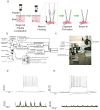In vivo robotics: the automation of neuroscience and other intact-system biological fields
- PMID: 23841584
- PMCID: PMC3797229
- DOI: 10.1111/nyas.12171
In vivo robotics: the automation of neuroscience and other intact-system biological fields
Abstract
Robotic and automation technologies have played a huge role in in vitro biological science, having proved critical for scientific endeavors such as genome sequencing and high-throughput screening. Robotic and automation strategies are beginning to play a greater role in in vivo and in situ sciences, especially when it comes to the difficult in vivo experiments required for understanding the neural mechanisms of behavior and disease. In this perspective, we discuss the prospects for robotics and automation to influence neuroscientific and intact-system biology fields. We discuss how robotic innovations might be created to open up new frontiers in basic and applied neuroscience and present a concrete example with our recent automation of in vivo whole-cell patch clamp electrophysiology of neurons in the living mouse brain.
Keywords: neuroscience; patch clamping; robotics.
© 2013 New York Academy of Sciences.
Conflict of interest statement
C.R.F., E.S.B., and S.B.K. are co-inventors on a patent owned by MIT and Georgia Institute of Technology. C.R.F. and S.B.K. are financially affiliated with Neuromatic Devices, which is seeking to manufacture and sell autopatching robots.
Figures


Similar articles
-
Automated whole-cell patch-clamp electrophysiology of neurons in vivo.Nat Methods. 2012 Jun;9(6):585-7. doi: 10.1038/nmeth.1993. Epub 2012 May 6. Nat Methods. 2012. PMID: 22561988 Free PMC article.
-
Robotic Automation of In Vivo Two-Photon Targeted Whole-Cell Patch-Clamp Electrophysiology.Neuron. 2017 Aug 30;95(5):1048-1055.e3. doi: 10.1016/j.neuron.2017.08.018. Neuron. 2017. PMID: 28858615 Free PMC article.
-
Advances in the automation of whole-cell patch clamp technology.J Neurosci Methods. 2019 Oct 1;326:108357. doi: 10.1016/j.jneumeth.2019.108357. Epub 2019 Jul 20. J Neurosci Methods. 2019. PMID: 31336060 Review.
-
Multi-neuron intracellular recording in vivo via interacting autopatching robots.Elife. 2018 Jan 3;7:e24656. doi: 10.7554/eLife.24656. Elife. 2018. PMID: 29297466 Free PMC article.
-
Progress in automating patch clamp cellular physiology.Brain Neurosci Adv. 2018 May 17;2:2398212818776561. doi: 10.1177/2398212818776561. eCollection 2018 Jan-Dec. Brain Neurosci Adv. 2018. PMID: 32166142 Free PMC article. Review.
Cited by
-
High-throughput genetic manipulation of multicellular organisms using a machine-vision guided embryonic microinjection robot.Genetics. 2024 Apr 3;226(4):iyae025. doi: 10.1093/genetics/iyae025. Genetics. 2024. PMID: 38373262 Free PMC article.
-
MATLAB-based automated patch-clamp system for awake behaving mice.J Neurophysiol. 2015 Aug;114(2):1331-45. doi: 10.1152/jn.00025.2015. Epub 2015 Jun 17. J Neurophysiol. 2015. PMID: 26084901 Free PMC article.
-
Protection and Repair After Spinal Cord Injury: Accomplishments and Future Directions.Top Spinal Cord Inj Rehabil. 2015 Spring;21(2):174-87. doi: 10.1310/sci2102-174. Epub 2015 Apr 12. Top Spinal Cord Inj Rehabil. 2015. PMID: 26364287 Free PMC article.
-
AutoRG: An automatized reach-to-grasp platform technology for assessing forelimb motor function, neural circuit activation, and cognition in rodents.J Neurosci Methods. 2023 Mar 1;387:109798. doi: 10.1016/j.jneumeth.2023.109798. Epub 2023 Jan 20. J Neurosci Methods. 2023. PMID: 36682731 Free PMC article.
-
Cleaning patch-clamp pipettes for immediate reuse.Sci Rep. 2016 Oct 11;6:35001. doi: 10.1038/srep35001. Sci Rep. 2016. PMID: 27725751 Free PMC article.
References
-
- Thorsen T, Maerkl SJ, Quake SR. Microfluidic Large-Scale Integration. Science. 2002;298:580–584. - PubMed
Publication types
MeSH terms
Grants and funding
- R01 DA029639/DA/NIDA NIH HHS/United States
- 1R01NS075421/NS/NINDS NIH HHS/United States
- R01 EY023173/EY/NEI NIH HHS/United States
- R01 GM104948/GM/NIGMS NIH HHS/United States
- 1R01DA029639/DA/NIDA NIH HHS/United States
- 1R01GM104948/GM/NIGMS NIH HHS/United States
- R01 NS075421/NS/NINDS NIH HHS/United States
- R01 NS067199/NS/NINDS NIH HHS/United States
- T90 DA032466/DA/NIDA NIH HHS/United States
- DA032466-02/DA/NIDA NIH HHS/United States
- DP2 OD002002/OD/NIH HHS/United States
- 1 R01EY023173/EY/NEI NIH HHS/United States
- 1DP2OD002002/OD/NIH HHS/United States
- 1R01NS067199/NS/NINDS NIH HHS/United States
LinkOut - more resources
Full Text Sources
Other Literature Sources

